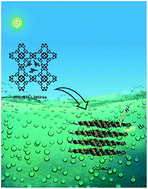An in situ porous cuprous oxide/nitrogen-rich graphitic carbon nanocomposite derived from a metal–organic framework for visible light driven hydrogen evolution†
Abstract
We report a simple methodology for synthesizing a hybrid of cuprous oxide (Cu2O) nanoparticles with a size less than 6 nm embedded into a porous graphitic nitrogen-rich carbon matrix. The mesoporous composite, Cu2O@C3N, with a surface area of 112 m2 g−1 was prepared by mild pyrolysis (450 °C) of a copper based metal organic framework, Cu3(BTC)2 loaded with urea, (H2N)2CO. The Cu2O@C3N shows a band gap energy of 1.97 eV and acts as an efficient photocatalyst for hydrogen evolution from water under visible light. The amount of evolved H2 is more than 2 times higher than that evolved over pristine carbon nitride and cuprous oxide under the same conditions. Importantly, the composite maintains its catalytic activity even after three catalytic cycles maintaining similar yields. Therefore, the nitrogen-rich porous carbon support serves as a functional scaffold preventing the agglomeration of Cu2O nanoparticles. The key factors responsible for enhanced hydrogen evolution from water are improved visible light absorption, suppressed charge carrier recombination, increased charge separation and high surface area of the composite. We investigated the effect of different pyrolysis temperatures set at 550 and 700 °C on the photocatalytic hydrogen evolution rates. The pyrolysis conditions affect not only the phase transition of copper (copper oxide at 550 °C and pure copper metal at 700 °C) in the resultant composites, but also nitrogen amount incorporation. We believe that this work provides a new insight into the design and fabrication of various efficient and cost-effective nitrogen-rich carbon composites (alternative for noble metals) with superior photocatalytic hydrogen evolution activity.


 Please wait while we load your content...
Please wait while we load your content...